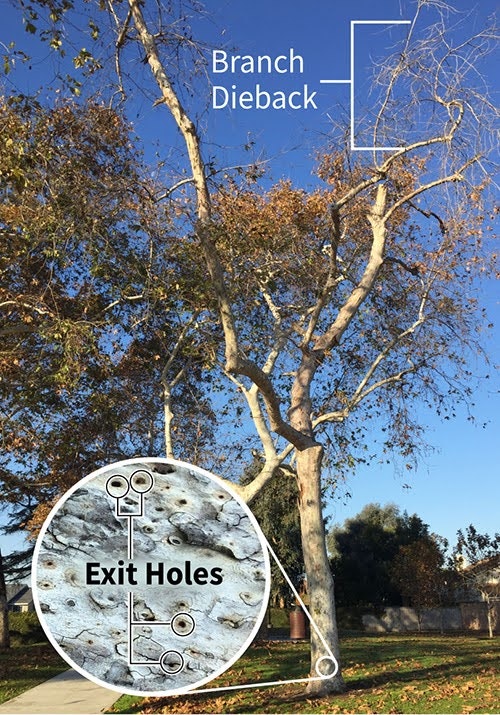Invasive Shothole Borer

Invasive shothole borer (ISHB) is a type of beetle that is smaller than a sesame seed, but can infest and harm a variety of trees. The beetle presents an ongoing management issue for urban and riparian forests in Southern California. The name “shothole borer” comes from the characteristic holes left in the bark by the beetle entering or exiting a tree.
As a type of ambrosia beetle, these insects carry spores of a symbiotic fungus. This fungus grows and spreads in the wood of the tree, providing the food source that the beetles depend on to grow and reproduce inside the tree. As the beetles and their symbiotic fungus colonize and grow within a tree, the fungus will block the tree’s vascular system and the transport of water and nutrients. This causes damage to the trunk and branches of the infested tree. An ISHB infested tree can decline in health, and ISHB can kill the tree if the infestation is severe enough.
What We Do
.jpg?ixlib=rb-1.1.0&w=2000&h=2000&fit=max&or=90&s=d9045127f85b872314bde1d9259ef4d4)
From 2021 to 2023, the IERCD managed a comprehensive Invasive shothole borer (ISHB) surveying program, funded through a CAL FIRE grant. The program aimed to monitor the spread of ISHB and contribute to ISHB management within IERCD boundaries, specifically focusing on the upper Santa Ana River and Mojave River watersheds. The monitoring work included both trapping and surveying. Trapping for ISHB involves deploying sticky panel traps with Quercivirol lures in strategic locations within riparian and urban green spaces. The survey component involves examining individual trees at parks and green spaces for signs of ISHB infestation. A key deliverable of the grant was the ISHB Regional Priority Plan which includes an overview of ISHB biology, distribution in our region, and information for decision-makers and landowners such as cities and Homeowners Associations about how to manage ISHB. While the CAL FIRE grant supporting this ISHB project has concluded, IERCD’s Forestry Team continues to monitor ISHB’s distribution and spread through a limited network of traps throughout the district from spring to fall.

Confimed Areas of Infestation within our District:
%20(1).jpg?ixlib=rb-1.1.0&w=2000&h=2000&fit=max&or=0&s=5f3a30298de4aa7b5cabc446a7f3bacd)
Click here to view all confimed areas of infestation.
Introduction to Invasive Shothole Borers
Resources: Click to Download


